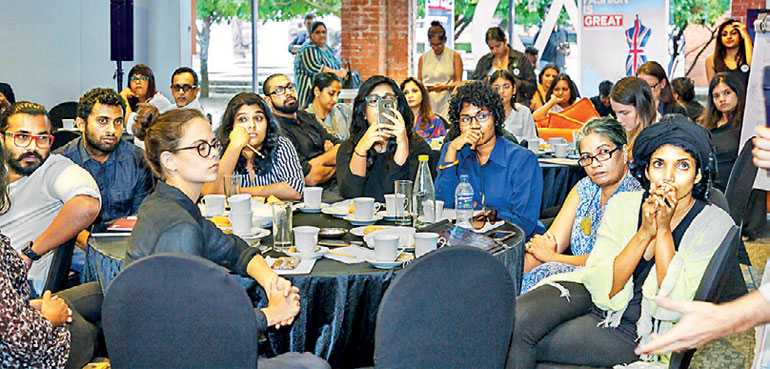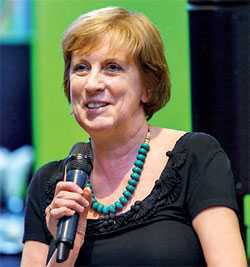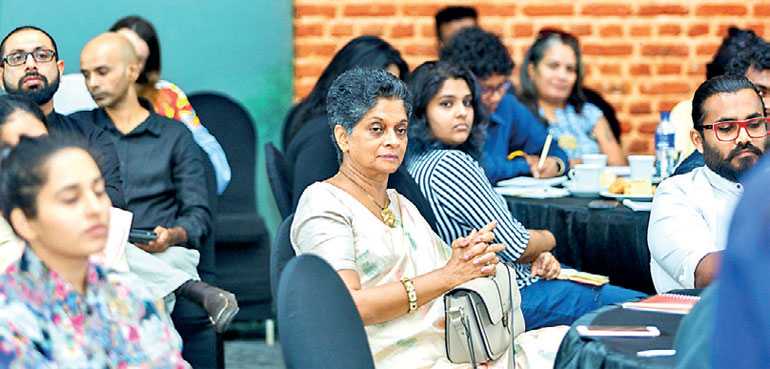Tuesday Dec 09, 2025
Tuesday Dec 09, 2025
Friday, 23 November 2018 00:00 - - {{hitsCtrl.values.hits}}

 |
 |
 |
Gill Caldicott - Country Director,
|
Sheilagh Wright |
Selyna Peiris - Director
|
The British Council brought in UK’s expertise to support the development of the Lankan creative industries, stimulate the country’s creative economy, and unleash its true potential. Following the first talks for a national creative industries’ game plan held back in December 2017, a Creative Economy Policy Forum was held recently as a big step further in the same direction. A meeting of like-minded creative professionals, policy makers and industry experts, was held at the recently concluded Sri Lanka Design Festival 2018 at Trace Expert City Colombo.
With the aim of bringing a global perspective into what could be Sri Lanka’s most progressive economic sector, AOD and Sri Lanka Design Festival collaborated with the British Council to discuss and map out a national policy for harnessing the creative industries’ of the island. With Britain’s expertise in nurturing and drawing out the power of creativity to build the economy, this partnership brings in a much-needed global viewpoint to Sri Lanka’s journey in broadening its economy. The Creative Economy Policy Forum held as part of this collaboration was led by creative economy expert Shelagh Wright from the UK. Wright offered experience and insight from the UK creative economic development, opportunities, strategies and learning, building on the strategic direction set in last December’s meeting.
AOD and Sri Lanka Design Festival collaborated with the British Council to discuss and map out a national policy for harnessing the creative industries’ of the island. With Britain’s expertise in nurturing and drawing out the power of creativity to build the economy, this partnership brings in a much-needed global viewpoint to Sri Lanka’s journey in broadening its economy. The Creative Economy Policy Forum held as part of this collaboration was led by creative economy expert Shelagh Wright from the UK. Wright offered experience and insight from the UK creative economic development, opportunities, strategies and learning, building on the strategic direction set in last December’s meeting.
Wright discussed how the creative industries do not exist in isolation, need to be tailor-made for each country or locality, how developing nations have CIs developing faster than other sectors, the inherent relationship between the creative industries with the arts, culture and heritage and the importance of getting the balance right between ‘creative’ and ‘economy’. She highlighted how “creative industries thrive in diversity”, saying that “CIs develop through different people with diverse cultural perspectives and different kinds of knowledge like universities, museums, research institutions...and different habits and ways of meeting like coffee shops, clubs, cultural and entertainment venues. It is often said that for the creative sector to flourish, a diversity of skills is more important than any one skill.”
She reassured the audience that even in the most mature creative economies like that in the UK, “everyone is still experimenting, and no one has all the answers…” She urged the Lankan creative practitioners to “be open, share ideas, voice issues, try things and above all, collaborate!” She added that more information, practical action and political support would be necessary as the Lankan CIs develop, but to begin with, low cost workspaces, meeting places for diverse creatives and good digital connectivity will get the ball rolling. Her viewpoints allowed the audience to understand the realities in developing a creative economy, how everyone has a role in it, and how it should transcend politics to become an essential national policy framework recognised for its potent economic capacity.
Wright’s audience at the forum included international opinion formers and leaders in creative fields, taking the discussion forward with local practitioners and thought leaders, practicing designers, creative entrepreneurs, design academics, innovators and professionals in design related industries like apparel and tech. In addition, in a bid to provide an inclusive platform, and a wider commitment, creative leaders working in the performing arts, visual arts, music, theatre, craft, film and dance were also invited to be part of the discussion. From this diverse audience, a core working group was established to take forward policy discussion, strategy development and action for sector development.
Linda Speldewinde, the entrepreneur behind AOD and Sri Lanka Design Festival, mentioned that it was important for Sri Lanka to develop its creative economy through a holistic integrated creative community. Well-known photographer Kesara Ratnavibhushana contributed his thoughts, adding that Sri Lankan society is receptive to new creativity, and that the island is in fact, ready for a mature creative economy. Sumanthri Samarawickrema, senior lecturer at the University of Moratuwa’s Department of Integrated Design, said that local businesses also need to develop at the same pace as the Lankan creativity is developing, asking the question: “Is the industry really ready for the design graduates we produce?”
Selyna Peiris, the Business Development Manager at Selyn Handlooms highlighted a key issue we face when discussing the creative economy in Sri Lanka, which has to do with an actual fact and research-based mapping of the creative industries available in the island: “I tried to track down the economic impact that craft has had on our economy, and I couldn’t. And there lies the problem. We don’t know how much these sectors actually contribute. Everything is largely concentrated into this SME sector. Because these are mostly occupied by women, every time there is a situation to do something for women there comes the handloom, there comes the workshops, the funds … and it’s not all in vain. But, without a method, a strategy, it is a lot of money and effort to get wasted on what we assume.”
Further, the Creative Economy Policy Forum discussed how Sri Lanka’s creative talent and mature industrial infrastructures can be linked to new opportunities, interesting collaborations, untapped markets across the globe, through a focused national policy in creating business out of innovative creative and cultural thinking. Both British Council and AOD have been advocating Sri Lanka as a promising landscape for a thriving creative economy, and the creative industries to hold enormous potential in the progression of the island. British Council’s expertise on the topic derives from its work around the world in helping to establish creative economies, and through Britain’s global leadership as the world’s creative capital.
British Council Sri Lanka Country Director Gill Caldicott stated that Britain’s collective knowledge on generating enormous economic growth by harnessing the ingenuity of its people, is key to their work around the globe, including Sri Lanka. “UK’s creative industries are worth £92bn a year to the economy. The creative industries are growing twice as fast as the economy as a whole. They are also significant job creators, and have the potential to create thousands of new employment opportunities for Sri Lankans. Developing the creative industries also carry deeper values such as inclusive social development to facilitating new understanding between people. We know how effective the creative industries are and we’re keen to support inclusive growth Sri Lanka.” Caldicott added that the British Council’s involvement at the Creative Economy Policy Forum derived from this thinking.
The forum played a vital role in getting the creative community together to assemble the key learnings required to draw up an effective policy for building a creative economy in Sri Lanka. It identified immediate practical actions and established a commitment to make this happen in an agreed timescale. The outcomes of the forum will form the essential data, insights and the framework for creative economic development in Sri Lanka with clear priorities, responsibilities and timelines.
For more information how the British Council works in the Creative Economy, visit: https://creativeconomy.britishcouncil.org
